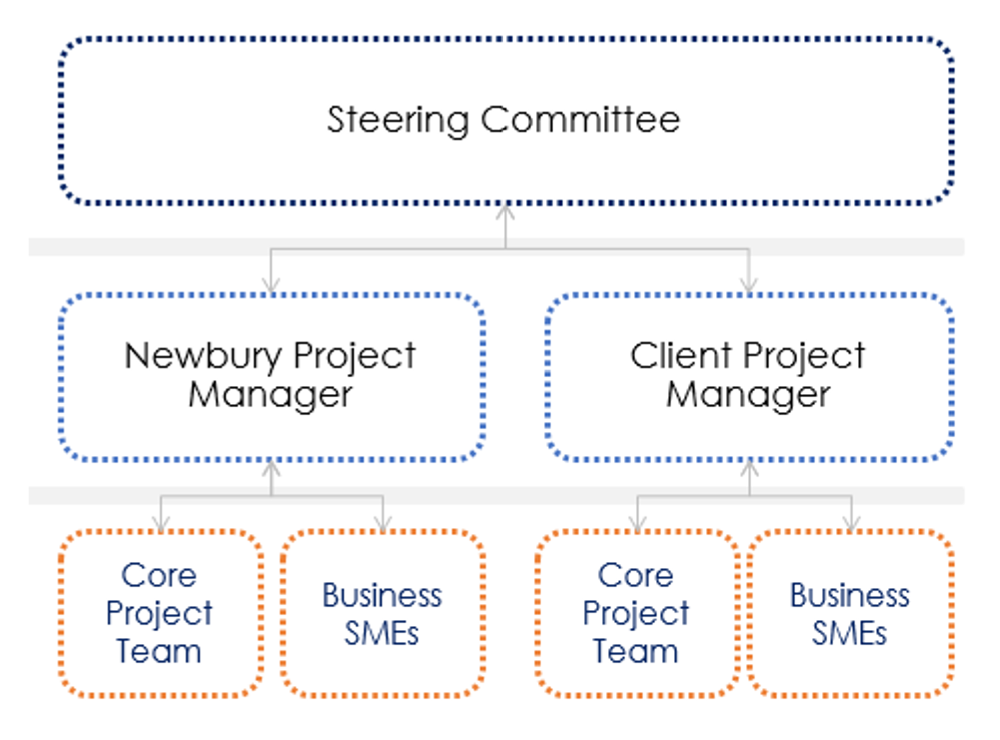Part One of a Three Part Series
Choosing new software for your business is one of the most important decisions you’ll make. Deciding how to ensure that your software’s implementation is successful—and how to help users quickly adapt to the change—are just as important.
Planning for success starts prior to the implementation kick-off call. Ask yourself:
- Have you identified the right team members?
- Has a governance structure been established to identify potential project risks and escalations?
- Is your data “clean” and ready to be imported into a new application?
- Do you know what a successful implementation will look like?
Answering “yes” to all these questions—and using the following planning steps—can help ensure successful software implementation.
Step 1: Assemble and Govern Your Team
Be sure that every member of your team can give enough time to the software implementation project to ensure its success—while also giving enough time to successfully handle their other job responsibilities.
Your team should have a governance structure to ensure accountability and an open flow of communication between all project stakeholders. It should include:
- Steering Committee – This group includes executive decisionmakers who set the project’s direction. The Steering Committee is also the escalation point for major issues.
- Project Manager – This single point of contact owns the software implementation project from start to finish. Their ability to align the entire team and keep it on task is critical; if an ideal Project Manager isn’t already in your organization, consider hiring a third party. A good Project Manager:
- Effectively manages every step of the process, including scope, schedule and budget.
- Provides regular updates to project stakeholders.
- Escalates risks and issues with the Steering Committee.
- Keeps team members on track.
- Wakes up every day thinking how to make the project successful.
- Sifts through noise, identifying key items based on organizational goals and priorities.
- Devotes at least 10 hours a week to the project. (May vary depending on the size of the project.)
- Core Project Team – These team members:
- Execute project deliverables.
- Provide feedback on design requirements.
- Coordinate and communicate processes to their business areas.
- Business Subject Matter Experts (SMEs) – These team members provide valuable expertise, keeping the project moving forward as each element is implemented. SMEs:
- Have deep knowledge of your organization’s processes.
- Provide feedback on design requirements.
- Clarify end-user objectives.
- Help avoid missed requirements and gaps in the software solution.
- Should have their workday involvement in the team fully supported by your organization to ensure timelines are met. (This isn’t an “after hours” activity.)
- Should number about 1 for every 20 software end users. (Ratio should be adjusted depending on size of functional areas for business and operations teams such as recruiting, sales, billing, contracts, etc.)

Step 2: Prepare Data
Preparing data in advance of the project will streamline tasks and keep the project on track.
- Ensure there’s quality data in the legacy system. Can anything be cleaned up in the legacy system over time? Check out our tips to achieve data quality.
- Start working to secure data backups. Examine the contract with your current data backup provider: Does it influence the project timeline?
Step 3: Prepare Reporting
Don’t just re-create reports from your current software system without examining whether those reports are purposeful and provide value. Instead:
- Compile a list of management and operational reports.
- Identify which reports are being used and which ones aren’t.
- Determine whether you can combine multiple reports.
- Ensure you’re soliciting feedback from producers on the floor as well as middle/back office teams at all levels—from individual contributors to executive management.
Step 4: Define Criteria for Success
Set the project’s core objectives to be achieved and key challenges it should solve. High-performing organizations can clearly document key challenges; the highest-performing organizations can tie those challenges back to Key Performance Indicators, allowing the data to tell a story after the software update goes live. A short list of objectives can contextualize important implementation decisions and ensure the projects remain on track during the busy implementation to come.
Joe Calzone is the Vice President of Newbury Partner’s Front Office team. His team helps staffing companies of all sizes in their front office ATS configuration, driving and implementing automations, all while instilling best practices with their process configuration expertise.
Sean Beatty is the Vice President of Newbury Partners’ Middle Office team. Sean and his team provide advisement and implementation services to the Staffing Industry in the areas of contract administration, drug and background program management, time capture, payroll and billing. He and his team also specialize in Continuous Improvement utilizing the Lean Six Sigma methodology to help you operationalize and drive efficiencies for your finance teams.
Email Joe (joe.calzone@newburypartners.com) or Sean (Sean.Beatty@newburypartners.com) to learn more about how their teams can help your organization with best practice processes and efficiencies to positively impact and help streamline your business.
To receive future blog posts and content, follow us on LinkedIn.

